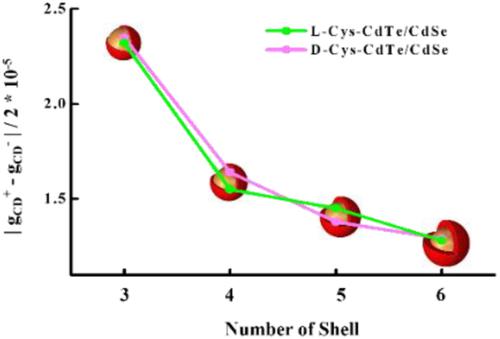Our official English website, www.x-mol.net, welcomes your
feedback! (Note: you will need to create a separate account there.)
Controllable chiral behavior of type‐II core/shell quantum dots adjusted by shell thickness and coordinated ligands
Chirality ( IF 2.8 ) Pub Date : 2021-01-19 , DOI: 10.1002/chir.23298 Xiao Shao 1 , Tianyong Zhang 1, 2, 3 , Bin Li 1, 2 , Yue Wu 1 , Siyi Li 1 , Jingchao Wang 1 , Shuang Jiang 1
Chirality ( IF 2.8 ) Pub Date : 2021-01-19 , DOI: 10.1002/chir.23298 Xiao Shao 1 , Tianyong Zhang 1, 2, 3 , Bin Li 1, 2 , Yue Wu 1 , Siyi Li 1 , Jingchao Wang 1 , Shuang Jiang 1
Affiliation

|
Chiral semiconductor nanomaterials induced by capped chiral ligands are of great interest for both theoretical studies and advanced applications. In this study, CdTe/CdSe quantum dots (QDs), defined as type‐II core/shell nanostructure, with the advantage of a good separation of holes and electrons are imparted chirality with L/D‐cysteine and L/D‐penicillamine molecules. Circular dichroism (CD) at exciton transitions from cysteine‐ and penicillamine‐capped QDs is different in shape and intensity. CD intensities decrease with increasing shell thickness from three monolayers to six monolayers, indicating a decreased hybridization degree between the holes in CdTe core and the electrons in chiral ligands. Elevated cysteine concentration leads to decreased g‐factor, probably due to an altered binding mode from tridentate to bidentate. Our observations provide further insights into the understanding of chiral phenomenon as well as optimized design and applications of chiral nanostructures.
中文翻译:

II型核/壳量子点的可控手性受壳厚度和配位体的调节
由封端的手性配体诱导的手性半导体纳米材料对于理论研究和高级应用都具有极大的兴趣。在这项研究中,定义为II型核/壳纳米结构的CdTe / CdSe量子点(QD)具有良好的空穴和电子分离优势,从而使L / D-半胱氨酸和L / D-青霉胺分子具有手性。半胱氨酸和青霉胺封端的量子点在激子跃迁处的圆二色性(CD)在形状和强度上都不同。CD强度随壳厚度的增加而从3个单层降低到6个单层,表明CdTe核中的空穴与手性配体中的电子之间的杂交度降低。半胱氨酸浓度升高会导致g因子降低,这可能是由于从三齿状到双齿状的结合模式改变所致。
更新日期:2021-03-09
中文翻译:

II型核/壳量子点的可控手性受壳厚度和配位体的调节
由封端的手性配体诱导的手性半导体纳米材料对于理论研究和高级应用都具有极大的兴趣。在这项研究中,定义为II型核/壳纳米结构的CdTe / CdSe量子点(QD)具有良好的空穴和电子分离优势,从而使L / D-半胱氨酸和L / D-青霉胺分子具有手性。半胱氨酸和青霉胺封端的量子点在激子跃迁处的圆二色性(CD)在形状和强度上都不同。CD强度随壳厚度的增加而从3个单层降低到6个单层,表明CdTe核中的空穴与手性配体中的电子之间的杂交度降低。半胱氨酸浓度升高会导致g因子降低,这可能是由于从三齿状到双齿状的结合模式改变所致。











































 京公网安备 11010802027423号
京公网安备 11010802027423号